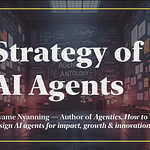🎙 Episode 40: Atlassian’s Secrets to Successful Agents
In this episode, Jamil Valliani (VP & Head of Product AI at Atlassian) shares how they embed AI across Jira, Confluence, and Trello through intelligent agents that blend into workflows—far from mere “+AI” buttons. He emphasizes starting small with tangible prototypes to build momentum and leadership alignment, showing that AI gains stick when they're experienced, not explained.
Highlights from the episode:
Hands-on AI adoption at Atlassian: transforming workflows, not just products
From friction to flow: how prototypes bridge skepticism and trust
AI as teammate, not feature—designing for collaboration, not automation
Adoption baked into experience—make AI habitual, not optional
“The most successful teams will treat AI not as a button you press, but as a teammate you collaborate with.”
Listen on Spotify | Listen on Apple | Watch on YouTube —and share one workflow where AI acting more like a teammate could unlock unexpected value.
About the Guest:
Jamil Valliani brings two decades of product leadership (including 15 years at Microsoft) to Atlassian, where he’s spearheading AI-powered design.
Upcoming Workshop: AI Product Strategy
Product teams everywhere are facing the same challenge: leadership wants AI integration for competitive advantage, but without certainty about which AI products will actually be valuable to customers.
When: Thursday, September 18, 2025 (online)
What you’ll gain:
Diagnose the highest-leverage AI use cases
Prototype with precision—avoid costly detours
Craft a resilient strategy that scales beyond pilot phase
Register on Eventbrite and get a 2 for 1 promo.
Learn to Synthesize or Else
In a world awash with data, the real advantage lies not in knowing more—but in drawing clarity from the noise. Product and design leaders must become the translators of complexity, turning abundant knowledge into purposeful, actionable insight.
Emerging Shift: Role-Dissolving AI
Figma, OpenAI, and others are signaling a paradigm shift: AI is merging design, engineering, and research into a unified discipline. The competitive edge now lies in craft, judgment, and cross-disciplinary fluency—not siloed specialization.
AI Merging Tech Roles, Favoring Generalists: Figma CEO Dylan Field
Featured Video: Why Designers & Engineers Must Rethink Workflows for AI to Deliver Real Value
This video pressurizes teams to question legacy workflows. Without overhauling collaboration models, decision-making structures, and design intent, even advanced AI remains misunderstood or underleveraged.
Research To Reframe Your Strategy
1️⃣ Mixture of Reasoning (MoR)
Why it matters: LLMs can be trained to switch between reasoning styles—stepwise logic, analogies, symbolic reasoning—without prompt engineering.
Strategy shift: Build assistants that adapt reasoning to task: planning one moment, diagnosing the next.
Quick test: A/B fixed vs. adaptive reasoning in support/search flows to spot gains in mixed-query handling.
2️⃣ In-Context Learning as Implicit Weight Updates
Why it matters: Transformers tweak their own behavior on-the-fly based on prompt context—no retraining required.
Strategy shift: Enable products to adapt within interaction sessions, not over multiple deploy cycles.
Quick test: Prototype context-aware replies and monitor when users feel seen vs. served.
3️⃣ Chain-of-Thought (CoT) Monitorability
Why it matters: Exposing AI’s reasoning steps helps catch misalignment before it reaches users—but this safety window is fragile.
Strategy shift: Don’t equate explanation with trust. For high-stakes domains, embed traceability and risk alerts.
Quick test: Add CoT transparency to UX, measure user trust shifts when rationale is visible.
Follow my co-host, Brittany Hobbs for essential research and product insights news.
Your Next Challenge
Most teams drop AI into their products like sprinkles on a cupcake. But strategy—true product strategy—demands AI baked into the experience, from the core outward.
Reply here or email me.










